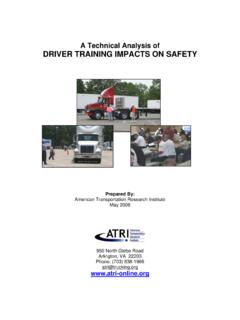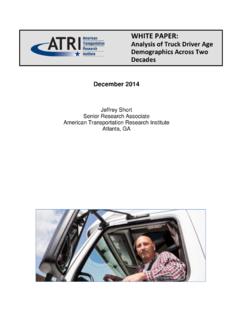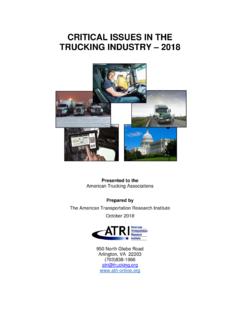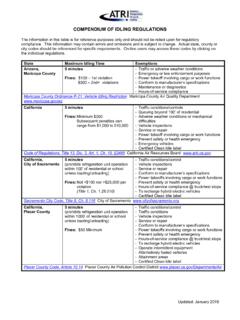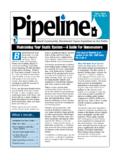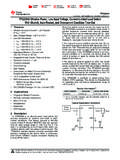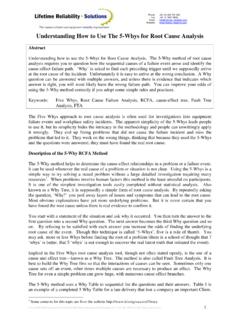Transcription of CRITICAL ISSUES IN THE TRUCKING INDUSTRY …
1 CRITICAL ISSUES IN THE. TRUCKING INDUSTRY 2017. Presented to the American TRUCKING Associations Prepared by The American Transportation Research Institute October 2017. 950 North Glebe Road Arlington, VA 22203. (703)838-1966. ATRI BOARD OF DIRECTORS. Judy McReynolds Robert E. Low Chairman of the President and CEO. ATRI Board Prime Inc. Chairman, President and CEO Springfield, MO. ArcBest Corporation Fort Smith, AR Rich McArdle President David S. Congdon UPS Freight Vice Chairman and CEO Richmond, VA. Old Dominion Freight Line Thomasville, NC Gregory L. Owen Head Coach and CEO. Michael L. Ducker Ability/ Tri-Modal Transportation President and CEO Services FedEx Freight Carson, CA. Memphis, TN. Annette Sandberg Rich Freeland President and CEO. President and COO Transsafe Consulting, LLC. Cummins Inc. Davenport, WA. Columbus, IN. Rebecca M. Brewster Hugh H. Fugleberg President and COO. President and COO American Transportation Great West Casualty Company Research Institute South Sioux City, NE Atlanta, GA.
2 Dave Huneryager Chris Spear President and CEO President and CEO. Tennessee TRUCKING Association American TRUCKING Associations Nashville, TN. Derek Leathers President and CEO. Werner Enterprises Omaha, NE. ATRI RESEARCH ADVISORY COMMITTEE. Scott Mugno, RAC Chairman Sanford Hodes Karen Rasmussen Vice President, Safety, Ryder System, Inc. President and CEO. Sustainability and Vehicle Senior Vice President and Deputy HELP Inc. Maintenance General Counsel FedEx Ground Wellington F. Roemer, III. Ken Howden President and CEO. Jon Blackham Director, 21st Century Truck Wellington F. Roemer Insurance, Policy and Government Affairs Partnership Inc. Canadian TRUCKING Alliance Department of Energy Lee Sarratt Amy Boerger Kelly Killingsworth Director of Safety Vice President, Sales VP of Inbound Transportation Hunt Cummins, Inc. Wal-mart Stores, Inc. Mark Savage Bill Brown Victoria King Deputy Chief Manager of Fleet Telematics VP Public Affairs Colorado State Patrol Southeastern Freight Lines UPS.
3 Andrea Sequin Michael Conyngham Dustin Koehl Director, Regulatory Services Director of Research Vice President, Sales and Schneider National, Inc. International Brotherhood of Marketing Teamsters Total Transportation of Mississippi Carl Stebbins Corporate Director of Bob Costello Caroline Mays Admissions and Marketing Senior Vice President and Chief Director, Freight and International New England Tractor Trailer Economist Trade Section Training School American TRUCKING Associations Texas DOT. Harold Sumerford, Jr. Tom Cuthbertson Brian McLaughlin Chief Executive Officer Vice President, Regulatory President J&M Tank Lines Compliance Trimble Transportation Mobility Omnitracs, LLC Minnetonka, MN James E. Ward President and CEO. Dennis Dellinger Lisa Mullings Bowman President President and CEO. Cargo Transporters National Association of Truck Stop Tom Weakley Operators Director of Operations Chip Duden Owner-Operator Independent Vice President, Strategic Business Tom Murtha Drivers Association Foundation Analytics Senior Planner Werner Enterprises Chicago Metropolitan Agency for Planning Paul J.
4 Enos Chief Executive Officer Brenda Neville Nevada TRUCKING Association President Iowa Motor Truck Association Scott George Chief Executive Officer Dean Newell TCW, Inc. Vice President, Safety Maverick, Inc. Mike Golias Director for Research, Steve Raetz Intermodal Freight Transportation Director of Research and Market Institute Intelligence University of Memphis Robinson Worldwide, Inc. Victor Hart Director of Safety DOT Transportation, Inc. CRITICAL ISSUES in the TRUCKING INDUSTRY 2017. The past year has seen continued legislative and regulatory activity affecting the TRUCKING INDUSTRY . However, unlike recent years, much of the regulatory activity in 2017. brought resolution to several CRITICAL INDUSTRY challenges. Chief among these actions was a final determination on the Federal Motor Carrier Safety Administration (FMCSA). Hours-of-Service (HOS) provisions, the removal of the barriers toward the implementation of FMCSA's Electronic Logging Device (ELD) mandate, and a final rule on the minimum entry-level CDL training requirements.
5 In March of this year, FMCSA released findings from their study on the impacts of the HOS restart provisions as mandated by Congress in December FMCSA's study did not find that the requirement for at least two nighttime periods of rest and the prohibition on taking more than one restart per week provided a greater net safety benefit than the previous restart regulations while also finding that the restarts benefitted the ability of drivers to recover from fatigue and sleep loss regardless of the restart provision used. 2 As such, the 34-hour restart rule was restored in full force, while the other restart provisions will not be FMCSA's ELD mandate also overcame several last-minute challenges to its implementation, ending a protracted process and ensuring that the mandate will go into effect on December 18, 2017. The Supreme Court denied the Owner-Operator Independent Drivers Association's request for a rejection of the rule on June 12, A final effort to delay the ELD mandate by members of the House of Representatives also failed to pass in September of this FMCSA's Entry-Level Driver Training (ELDT) rule finally went into effect on June 5, The rule, which has a compliance date of February 7, 2020, states that no entry- level driver can take a Commercial Driver License (CDL) skills test without first completing a mandatory knowledge and behind-the-wheel training The three-year compliance window provides time for commercial driver training entities to come into compliance with the rule's requirements and be certified and listed on FMCSA's Training Provider Registry.
6 1 Frequently Asked Questions: Commercial Motor Vehicle (CMV) Driver Restart Study. Federal Motor Carrier Safety Administration. Washington DC. 8 March, 2017. Available online: analysis/research/frequently-asked-quest ions-commercial-motor-vehicle-cmv-driver 2 Ibid. 3 Ibid. 4 Supreme Court Denies Hearing on ELD Lawsuit. Transport Topics. 12 June, 2017. Available online: 5 Mulero, Eugene. House Rejects Bid to Delay Dec. 18 ELD Mandate. Transport Topics. 7 September, 2017. Available online: 6 Cullen, David. FMCSA Finally Releases Entry-Level Driver Training Rule. Truckinginfo. Available online: 7 Frequently Asked Questions: Entry-Level Driver Training Final Rule. Federal Motor Carrier Safety Administration. Washington DC. 3 February, 2017. Available online: license/eldt/faqs American Transportation Research Institute CRITICAL ISSUES in the TRUCKING INDUSTRY - 2017 1. In addition to the legislative and regulatory changes that took place in 2017, ISSUES internal to the INDUSTRY continue to impact fleet operations.
7 The causes that underpin the growing shortage of commercial drivers and diesel technicians remained firmly in place over the past year, as viable solutions to the pervasive TRUCKING INDUSTRY staffing challenges have yet to emerge. Given these and numerous other ISSUES impacting the nation's freight system, the American TRUCKING Associations (ATA) and its Federation partners in the State TRUCKING Associations (STA) continually seek opportunities to identify and prioritize the INDUSTRY 's most pressing concerns. For the past 13 years, the INDUSTRY has relied on the American Transportation Research Institute's (ATRI's) annual INDUSTRY survey to better understand TRUCKING 's most CRITICAL ISSUES as well as to identify preferred strategies for addressing these ISSUES . ATRI's Top INDUSTRY ISSUES report is based on a robust survey methodology. The ISSUES and potential strategies were first identified by ATRI in collaboration with various TRUCKING stakeholder groups.
8 ATRI then conducted a large-scale survey distribution using its own contact database, ATRI's regular Sirius/XM radio show, major TRUCKING INDUSTRY trade press, and through the 50 State TRUCKING Associations. Survey respondents were asked to select their top three choices from the aforementioned list, and subsequently rank their top three preferred strategies corresponding to each selected issue . As evidence of the numerous and varied challenges currently facing the INDUSTRY , this year's survey generated 1,557 responses. Respondents represented INDUSTRY stakeholders across North America, including the , Canada, and Mexico. A majority of respondents were motor carriers ( ), with commercial drivers making up percent of the respondent pool, and other INDUSTRY stakeholders accounting for percent. Recognizing that the top INDUSTRY ISSUES impact motor carriers and commercial drivers differently, this year's report includes separate Top Ten lists specific to commercial drivers and motor carriers, in addition to the overall ranking.
9 This report presents the findings of the 2017 annual survey and analysis, and compares the findings of previous years' results (Table 3) providing insight into both the changing and emerging priorities of the TRUCKING INDUSTRY . American Transportation Research Institute CRITICAL ISSUES in the TRUCKING INDUSTRY - 2017 2. Top ISSUES Summary Among all respondents, the Driver Shortage surged six spots to top this year's list of INDUSTRY concerns, surpassing the ELD mandate which fell to second position and the HOS rules which moved down to the number three issue . The lack of available safe parking for trucks held steady as the fourth-biggest INDUSTRY issue , while further concern over high levels of INDUSTRY turnover caused Driver Retention to climb three positions and round out this year's top five ISSUES . ATRI develops the Top Ten list using a formula assigning quantitative values to respondents' rankings of ISSUES facing the INDUSTRY . An issue that is ranked by a respondent as most important receives three points, while an issue ranked second receives two points and an issue ranked third receives one point.
10 ISSUES that were not ranked by respondents do not receive any points. The total number of points is then added together to generate a prioritized list of INDUSTRY concerns. The issue with the highest number of points is, of course, identified as the top INDUSTRY issue . An INDUSTRY Concern Index (ICI) is presented to illustrate the relative level of concern from one issue to the next. The Top INDUSTRY issue receives an ICI of 100, and then all other ISSUES are indexed against this value. For example, if an issue receives an ICI of 50, it was calculated to have half the level of concern as the top issue . Each respondent was then asked to rank three strategies to address each of the ISSUES they selected in the previous step. These strategies were previously identified by stakeholders for their potential to address or mitigate the ISSUES . Values are then assigned to respondents' rankings for each of the three strategies and an average score is calculated based on all of the rankings to determine the most preferred strategy.
